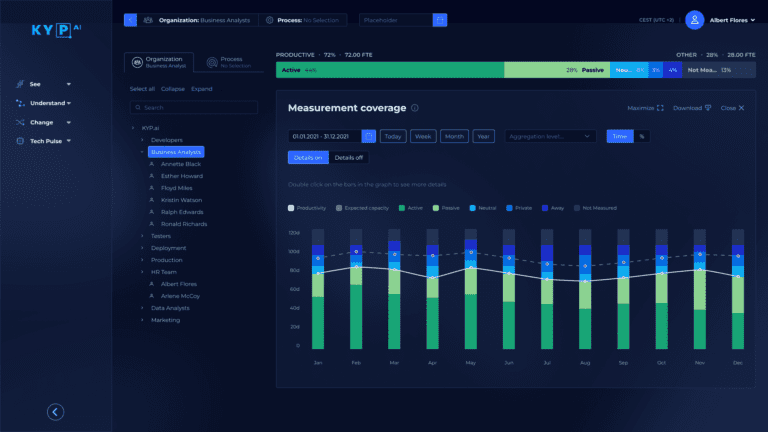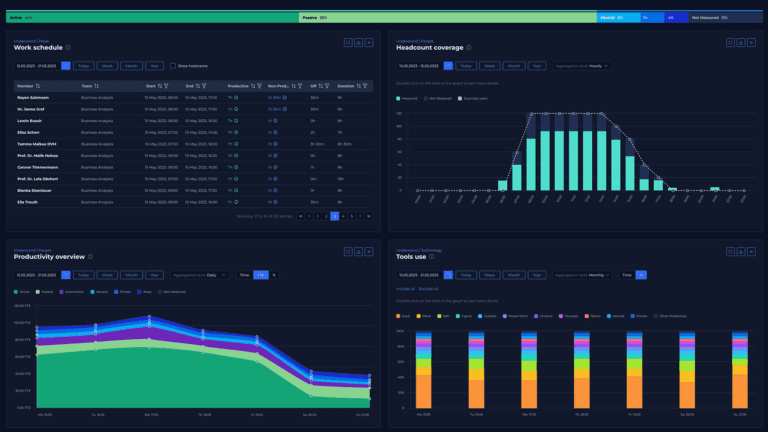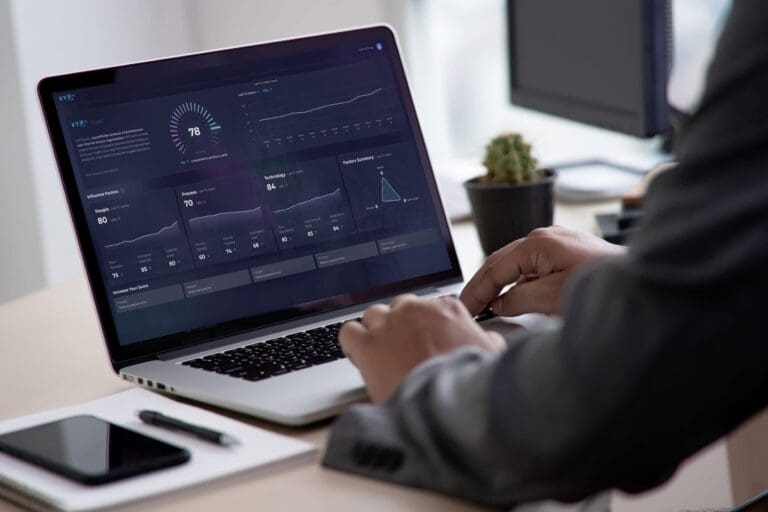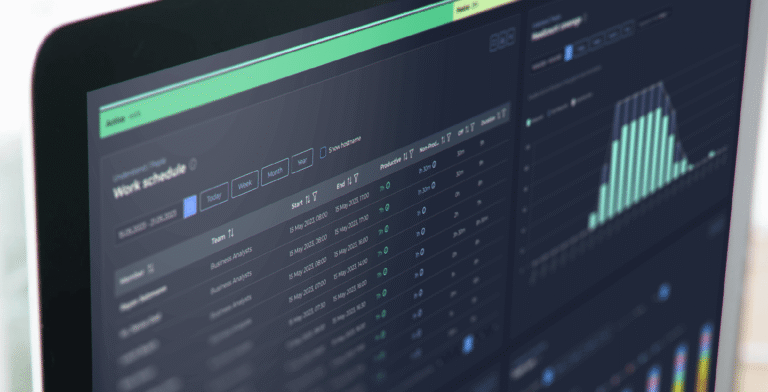| Summary: Process and data mining are complementary tools for driving business optimization. Data mining uncovers meaningful patterns in datasets while process mining reveals how to improve workflows across systems. Together, they help businesses boost efficiency, reduce costs, and make data-driven decisions. KYP.ai unifies both approaches to deliver measurable improvements. |
In the age of digital transformation, data has appeared as one of the most valuable assets for modern enterprises. But having data isn’t enough. The real advantage lies in what organizations do with it, how they interpret, act on, and learn from it.
This is where data mining and process mining have emerged as essential for business success. While often used interchangeably, these two disciplines serve very different purposes. Data mining extracts hidden patterns from vast data sets, while process mining clarifies how workflows within an organization.
Understanding data mining vs process mining and, more importantly, how they work together, can help companies unlock operational efficiency, uncover untapped potential, and build the intelligent enterprise of tomorrow.
This distinction matters more than ever if you aim for sustainable performance gains, improved visibility, and smarter decision-making.
Defining the Concepts
A. What Is Data Mining?
Data mining discovers patterns and relationships in large volumes of raw data. It uncovers correlations that humans are incapable of finding, using AI for computing power. Using a combination of statistics, machine learning, and analytics, it finds meaningful insights that are not immediately visible with human analysis alone.
Organizations across industries use data mining to:
- Identify customer segments and predict buying behavior
- Pinpoint where AI or automation could be used to improve business outcomes
- Detect fraud in financial transactions
- Optimize pricing and inventory management
- Understand risk profiles in insurance underwriting
- Personalize user experiences in digital services
In simple terms, data mining answers questions like:
- What’s likely to happen?
- Who is at risk?
- What do patterns indicate across my data?
It’s a broad-based analytical approach applicable to nearly any field that produces large, structured, or semi-structured data.
B. What Is Process Mining?
While data mining explores data, process mining focuses on how work gets done. It analyzes event logs generated by information systems to reconstruct real business processes. Event logs record computer events such as system start and stop times, user logins and logouts, and software or hardware errors.
Instead of guessing how a process works based on SOPs or stakeholder interviews, process mining uses a timestamped system data to generate a ground-truth capture of: What steps are being taken, in what order, by whom, and across which systems.
This makes it uniquely powerful for diagnosing delays, rework, handoff failures, and other hidden friction points that reduce productivity.
It also documents how a process runs, using AI to understand why it breaks down, how it differs from the planned path, and where it can be optimized.
Key Differences Between Data Mining Vs Process Mining
| Category | Data Mining | Process Mining |
| Level of Analysis | Pattern recognition across datasets | Workflow and process-level analysis |
| Data Source | Tables, databases, structured data | Event logs from systems (e.g., ERP, CRM, BPM) |
| Methodology | Classification, regression, clustering | Process discovery, conformance checking, and enhancement |
| Nature of Analysis | Horizontal (across variables) | Vertical (through process flows) |
| Exception Handling | Outlier detection in data | Deviations from defined process paths |
| Output | Trends, forecasts, anomalies | Process models, bottleneck maps, deviation flows |
| Business Use | Customer insights, churn prediction, and fraud detection | Process optimization, automation targeting, SOP compliance |
| Scope | Broad and domain-agnostic | Specific to business operations and workflows |
While both offer powerful insights, their applications and outputs differ significantly. It’s important to understand which option the right tool for the right problem.
Core Similarities
Despite their differences, process mining and data mining share a common foundation. Here’s where they align:
- Both use analytics, AI, and statistical techniques: From clustering and classification to machine learning and predictive modeling, both rely on advanced data science capabilities.
- Both demand clean, high-quality data: Whether you’re discovering a process path or a customer trend, messy or inconsistent data weakens insights.
- Visualization is key: Dashboards, flow diagrams, and heat maps are all outputs that require intuitive interfaces to make complex patterns digestible.
- Goal: Improve performance. At the core of both is the desire to make better decisions, faster, whether that’s improving customer experience, increasing throughput, or reducing waste.
These shared principles make them highly complementary when brought together strategically.
How Process Mining Leverages Data Mining
Process mining doesn’t replace data mining; it enhances it by applying its principles to operational workflows. Here’s how they work in a team:
A. Event Logs as Specialized Data Sets
Event logs, the fuel for process mining, contain structured, time-stamped sequences of actions tied to cases (like orders, applications, tickets). This unique format turns operational systems into rich data sources for performance analysis.
They are essentially datasets that capture what happened, when, how, and in what context. That’s why process mining offers a depth of visibility that data mining alone can’t achieve.
B. Integration of Mining Techniques
Modern platforms like KYP.ai treat these disciplines as a holistic view of the organization across people, processes, and technology. By embedding data mining techniques within process mining workflows organizations benefit from:
- Clustering: Helps group similar process paths, like distinguishing fast-track orders from ones that are slowed down by exception handling.
- Sequence mining identifies common and recurring chains of activities, revealing patterns that may not be immediately apparent.
- Predictive modeling: Surface cases trending toward SLA violations, compliance breaches, or costly rework raise alerts when rework, optimization, or other discovery is found
These techniques enhance root cause analysis and enable interventions.
C. Conformance Checking & Performance Analysis
With a reference model in place, statistical checks validate how closely reality matches expectations. For example:
- Is the process skipping mandatory approval steps?
- Are specific paths consistently leading to rework?
- Where is cycle time exceeding benchmarks?
- Are members using their own hacks to work in their preferred manner?
Conformance checking provides actionable insight, grounded in team, process, and systems activities.D. Enhancement and Optimization
Insights become most valuable when there is action taken from them. Process mining uses data-mined patterns to suggest specific changes:
- Re-routing handoffs
- Automating redundant steps
- Prioritizing high-impact variants
- Flagging non-compliant behavior
It becomes a continuous improvement engine, detecting, recommending, and validating changes over time.
Choosing the Right Approach for Your Business
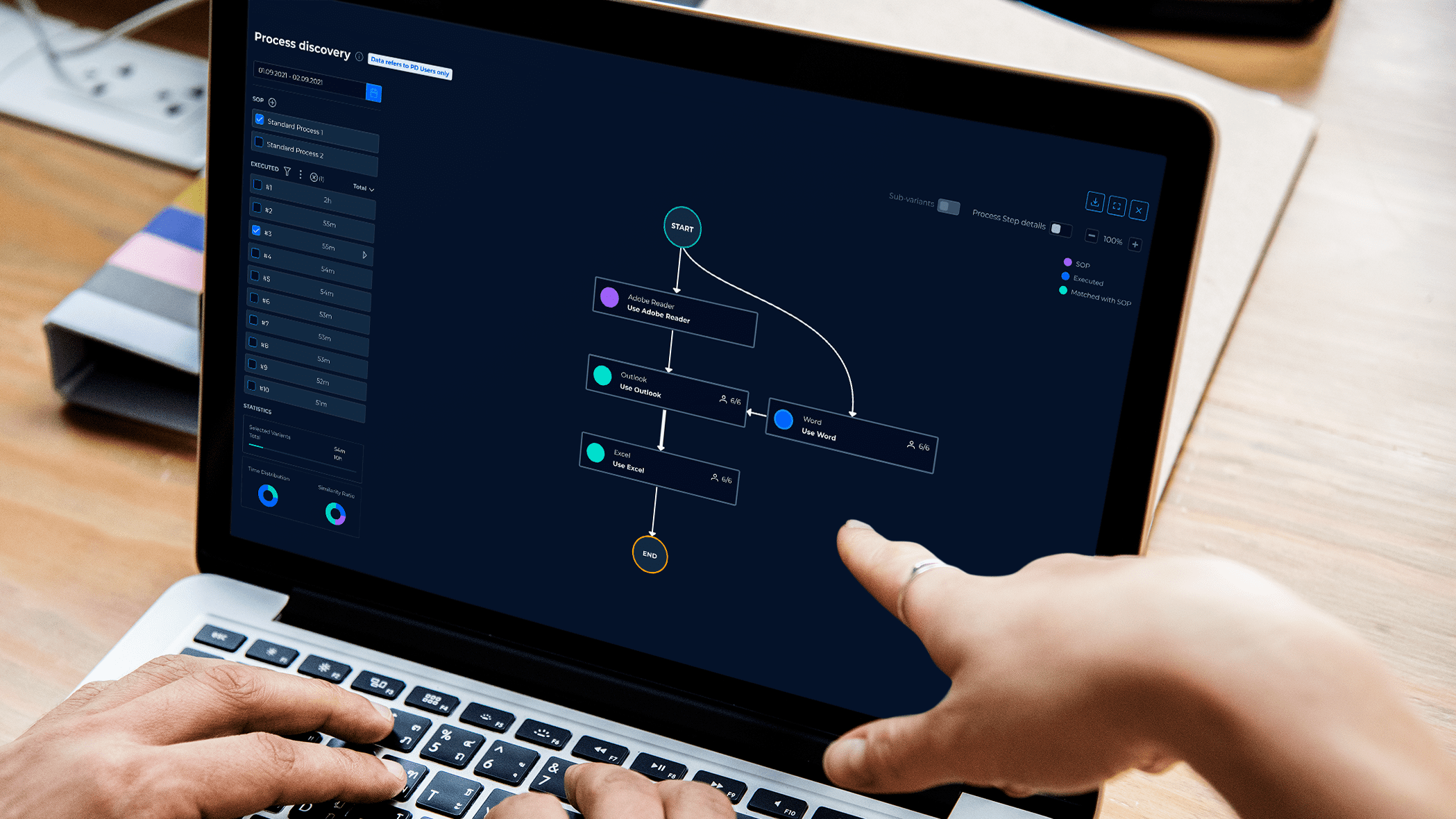
Both data mining and process mining are powerful. But applying them effectively requires context.
A. When to Use Data Mining
Data mining is the go-to approach when you’re working with large volumes of varied data and want to extract hidden patterns, correlations, or predictions. It excels in scenarios where the goal is to understand what is likely to happen next, based on historical trends and behaviors.
Use data mining when you need to:
- Insights across large, multi-dimensional datasets
- Predictions about customer churn, upsell potential, or buying cycles
- Detection of anomalies like fraudulent transactions or operational errors
- Market segmentation for personalized campaigns or offerings
It’s especially valuable in marketing, finance, insurance, and customer analytics.
B. When to Use Process Mining
Process mining, on the other hand, shines when your challenge is rooted in operational inefficiency or a lack of process transparency. It reconstructs the flow of work within your organization, how tasks move, where delays occur, and how closely your operations align with SOPs.
Use process mining when you need:
- End-to-end transparency into how work happens
- Identification of bottlenecks, handoff issues, or compliance deviations
- Insight into which processes are good candidates for automation
- A baseline for measuring and continuously improving performance
It’s a game-changer in operations, finance, procurement, shared services, HR, and customer support.
C. Synergistic Strategy: KYP.ai’s Integrated Approach
The real power emerges when these approaches are used together. KYP.ai doesn’t ask you to choose one or the other; it integrates both into a unified process intelligence platform that shows not just what’s happening, but why it’s happening and how to fix it.
Here’s how it works:
- Process mining provides a real-time view of how work flows across people, tools, and systems
- Data mining uncovers the deeper patterns, risks, and behavioral trends behind that flow
- AI brings it all together with recommendations on where to improve, automate, or optimize
The result is a connected strategy where insight leads to impact, without guesswork.
The KYP.ai Advantage
So why does KYP.ai stand out?
Because it’s built for the real-world complexity of enterprise operations. While others stop at visibility, KYP.ai delivers end-to-end intelligence:
- Captures the full spectrum of work: from desktop activity to system logs.
- Connects the dots: People, systems, time, and outcomes are all mapped clearly.
- Goes beyond mining: Embeds recommendations, performance tracking, and optimization tools.
- Supports intelligent automation: Identifies what to automate, when, and why.
- Aligns with digital workforce strategies: Whether scaling globally or managing change, it provides a control tower for operational excellence.
KYP.ai empowers teams to understand their processes and to transform them in real time, without heavy infrastructure changes or external consultants.
Conclusion
In today’s data-rich, results-driven world, organizations can no longer afford to fly blind. Both data mining and process mining offer paths to clarity, but they serve different roles in the journey.
Data mining helps spot trends and forecast behaviors. Process mining reveals operational truths hidden in the daily workflows.
Together, they unlock data-driven decisions, faster actions, and more sustainable growth.
The compounding power lies in integration, using platforms like KYP.ai to bridge the two, converting complexity into clarity and insight into outcomes.
The future of digital operations should consider how it will build connected intelligence that learns, adapts, and evolves with your business.
FAQs
Q: What is the main difference between process mining and data mining?
A: Data mining identifies patterns across datasets, while process mining maps and analyzes how business processes unfold based on event logs.
Q: Can process mining be used without data mining?
A: Yes. Process mining focuses on workflow analysis, but combining it with data mining provides deeper insight and stronger optimization recommendations.
Q: What types of organizations benefit most from process mining?
A: Enterprises with complex workflows, like finance, healthcare, shared services, or manufacturing, benefit most. However, any business with digital operations can gain value.
Q: How does KYP.ai use process and data mining together?
A: KYP.ai captures how work happens and applies AI-driven data mining to identify inefficiencies, recommend improvements, and prioritize automation efforts.
Q: Is process mining suitable for small and medium businesses?
A: Absolutely. SMBs can use process mining to eliminate inefficiencies, improve team productivity, and scale operations with clarity and confidence.
Discover Your Productivity Potential – Book a Demo Today
Book Demo